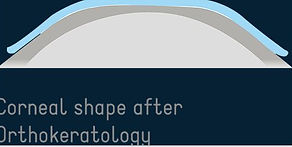Clearer Vision, Better Life | Call Today To Change Your Life | 中文
Orthokeratology

Successful Story:
HOUSTON – Brother and sister Justin and Aileen Liang are world champion jump rope athletes, and they say they couldn't compete with glasses on.
They also don't like to jump with contacts in, and even though they have poor eyesight, they jump with no vision correction at all, thanks to special sleeping contacts.
"They let me move around especially when I'm doing sports. I don't have to worry about getting dust in my eye or if I'm swimming I can just swim freely,” Justin Liang said.
Justin has been sleeping in these new contacts overnight for about four years. Aileen Liang has used them for just a few months. Neither of them has to wear anything during the day.
“Before I also wore contacts a little bit and they were like a little bit uncomfortable and they started drying up before like the end of the day,” Aileen Liang said.
Source: click2houston.com
What is Orthokeratology?
In the most basic of terms Accelerated Overnight Orthokeratology or Ortho-k is the science of changing the curvature or shape of the cornea to change how light is focused on the retina at the back of one's eye.
Think of the cornea as the eye's equivalent of a watch crystal. It is a clear, dome shaped structure that overlies the colored iris. Its tissue is most similar to clear, wet skin; and like skin it is very pliable. Because the cornea separates the eye from air and the rest of the outside world and because it has a curvature that bends light towards the back of the eye, it is responsible for most of the eye's corrective power and contributes to various conditions such as nearsightedness (myopia), farsightedness (hyperopia), and the blur of astigmatism.
When you choose Ortho-k a few key tests must be performed. Chief among these tests is the determination that your eyes are healthy. The Orthokeratologist will examine the retina and also the health of the outside of the eye. The other key procedure is the mapping of your cornea. To do this an instrument called a Topographer is used. Just like a topographical map of a camping area show hills, plains, and valleys; the topography of the eye shows your doctor exactly how your cornea is shaped. The information from your corneal mapping plus the size of your cornea and the prescription needed to correct your vision are all used to design the retainer lenses (corneal molds) needed to create the Ortho-k effect.
On the day you pick up your Ortho-k retainer lenses you will be instructed in how to insert, remove, and take care your vision retainers. The fit of your retainers will be evaluated and you will be scheduled to be seen after your first night of wear. On day 1, your doctor will re-evaluate your fit and newly corrected vision and another mapping of your cornea will be performed.
Throughout your initial fitting period, your Orthokeratologist will monitor your corneal health and the effectiveness of treatment. At certain times your retainer lens fit may be modified to achieve your goals.
Orthokeratology can produce results in a surprisingly short period of time. The length of treatment to achieve your goals can vary from patient to patient. Factors which can affect the speed of treatment include:
-
your initial prescription
-
corneal rigidity
-
tear quality and quantity
-
your expectations.
What Are the Benefits to See a Fellow (FIAOMC)
FIAOMC is A Fellowship in International Academy Of Orthokeratology And Myopia Control
Once your child is diagnosed with nearsightedness (myopia), it is recommended that you seek a practitioner who specializes in orthokeratology and myopia control. While most eye doctors practice general eye care, a myopia control specialist spends years educating themselves in this specialized aspect of eye care, which gives them the unique perspective of best understanding issues to do with myopia control.
Postgraduate fellowship training is part of this in-depth training to become a specialist. A fellowship is not a part of the basic medical eye care training but is a designation that is granted after years of advanced study.
An FIAOMC is a practitioner who has made a serious commitment to the practice of myopia control and orthokeratology. They have undergone hundreds of hours of advanced training in this field and have used this skill to manage myopia with various techniques successfully. While they are talented at treating all cases, they distinguish themselves with the ability to design and troubleshoot complex and challenging cases (highly nearsighted or astigmatic, abnormally shaped corneas, out-of-control myopia, to name a few). An FIAOMC is the gold standard representing the highest level of knowledge, ethics, and patient care in this field.
A doctor must meet several requirements prior to applying for a fellowship. Once these requirements have been met they may apply for the fellowship. The FIAOMC journey involves presenting several highly complicated cases that they have personally designed and managed. They must pass a 60+ question written test. Finally, they must sit for a 2-3 hour oral examination (administered by three experienced FIAOMCs) where they are presented difficult puzzling cases and the candidate must identify problems/solutions for each patient. If they demonstrate fellowship-level skills, they are only then granted their FIAOMC. The testing is rigorous. Dr Yachin Bao became the Fellow in 2011 and currently is one of 155 doctors world-wide who have successfully taken the journey.
Once they have attained their FIAOMC, a fellow is obligated to give back. Dr. Bao is one of elite group of doctors who demonstrate her commitment to myopia control through lectures, creating webinars, setting standards of care, educating the public, and mentoring other practitioners who have challenging cases. (Source: FIAOMC)
if you have any question or would like to make an appointment for consultation, please call us at 281-491-2199.


